Understanding Reduced Frequency Effect on Flutter Stability of Three-dimensional Transonic Compressor Blades
2022-07-09RuichaoShiYufangLiandDingxiWang
Ruichao Shi,Yufang Li,and Dingxi Wang
1Wuhan Second Ship Design and Research Institute,Wuhan,430205,China
2School of Power and Energy,Northwestern Polytechnical University,Xi’an,710129,China
3AVIC Xi’an Aircraft Industry Group Company Ltd.,Xi’an,710089,China
Abstract:It is well known that fan/compressor blade flutter stability increases with the increase of reduced frequency.Less well-known is that the least stable inter blade phase angle(IBPA)increases with the drop of reduced frequency.However,it is quite striking that little can be found in the open literature about the mechanism to the observations.In this paper,a numerical investigation is carried out to uncover the mechanism of the effect of reduced frequency on flutter stability and the least stable IBPA.The NASA rotor 67 has been used as the test vehicle with its first bending and torsion modes being considered.The time domain harmonic balance method together with the influence coefficient method is used to obtain the worksum-IBPA curves for all cases.It is found that:1)the deterioration of flutter stability with the decrease of reduced frequency is dictated by the dominant decrease of aerodamping due to a blade own vibration;2)the increase of the least stable IBPA with the decrease of reduced frequency arises largely from the increase of the least stable IBPA of the aerodamping from the nearest blade on a blade pressure side.
Keywords:Compressor Blade;Flutter;Reduced Frequency;Inter Blade Phase Angle
Nomenclature
Cblade chord length(m)
ffrequency(Hz)
kreduced frequency
pstatic pressure(Pa)
vinlet flow velocity(m/s)
WWorksum(J)
ωangular frequency(radian/s)
blade surface unit normal vector
grid velocity vector(m/s)
1 Introduction
Flutter is a self-excited vibration manifesting the instability of a fluid-structure coupled system.Once it occurs,the structural vibration amplitude grows exponentially with time until it enters a limited cycle vibration or leads to blade fracture straightaway.Therefore a lot of effort has been made with the goal of achieving flutter free turbomachinery designs.For example,the multi-million EuroFUTUREproject[1]was initiated to develop the technologies for such a purpose.
For long,some empirical rules have been developed to guide turbomachinery designs to avoid flutter.A simple popular empirical design rule is based upon the nondimensional parameter of reduced frequency.The definition of reduced frequency is given by

whereωis the angular frequency of a blade natural vibration mode,Cis the blade chord length andvis the relative flow velocity to the blade.Half of a blade chord is also used to define the reduced frequency.For a three dimensional blade,typically the chord length and relative flow velocity are taken at the blade upper span(say 75% span)[2].The rule of thumb based upon reduced frequency for flutter free design is to keep the reduced frequency bigger than 0.4 for the first vibration mode and bigger than 0.7 for the a torsion predominant mode[3].
It has been well known that increasing the reduced frequency can lead to enhanced flutter stability.Yang et al.[4]performed vibrating linear compressor cascade tests at three different reduced frequencies of 0.2,0.4 and 0.6.The cascade consists of seven blades with the middle blade being driven to vibrate at the direction normal to the blade chord.The influence coefficient method[5]was used to obtain aerodamping for each travelling wave mode.Resultsshow that the minimum aerodamping increases with the increase of reduced frequency.The least stable inter blade phase angle(IBPA)increases with the drop of reduced frequency.Huang et al.[6]performed vibrating linear turbine cascade tests also at three reduced frequencies of 0.2,0.4 and 0.6.Same as the results of the compressor cascade,the minimum aerodamping increases with the increase of reduced frequency.However the trend of the least stable IBPA against reduced frequency is just opposite:the least stable IBPA increases with the increase of reduced frequency.Waite et al.[7]analysed the sensitivity of aerodamping with respect to reduced frequency using the 4th standard configuration[8].Two dimensional analyses were performed for three different reduced frequencies:0.1,0.3 and 0.5.Resultsclearly demonstrate that the aerodamping increases with the rise of reduced frequency.Corral et al.[9]analyzed the influence of reduced frequency on the aerodamping of a two dimensional section of a low pressure turbine.Six reduced frequencies were considered:three are very low and they are 0.01,0.02 and 0.03,the other three are 0.3,0.4 and 0.6.Resultsreveal that minimum aerodamping increases with the increase of reduced frequency.Different from the results by Huang et al.[6],the least stable IBPA reduces with the increase of reduced frequency.This difference is believed to be from the difference in the sign convention of IBPA being used.Effort was made by Corral et al.[9]to uncover the physics behind the correlation between the least aerodamping and the reduced frequency.The non-dimensional work is decomposed to mean value plus one harmonic.The decomposition reveals that the mean work scales linearly with the reduced frequency,and reduces with the decrease of reduced frequency,while the first harmonic almost remains constant.This correlation is valuable for developing reduced order models.
From the literature review,one can clearly see that much more effort has been made to understand the mechanism of the effect of reduced frequency on flutter stability of turbine blades.This is probably attributed to the two dimensionality of the flow field within flutter prone low pressure turbines due to blade’s high aspect ratio.The flow field within fan/compressor blades has strong three dimensionality due to their much lower aspect ratios,thus any numerical investigation of flutter mechanism needs three dimensional unsteady flow field analysis which is very costly,particularly in the circumstances of parametric study.In this paper,a series of three dimensional unsteady flow analyses have been conducted using an efficient hybrid time and frequency domain flow solver,with the aim of understanding the mechanism of flutter stability dependence on reduced frequency.The influence coefficient method has been employed to obtain worksum or aerodamping at different IBPAs.
2 Numerical methods
In this investigation,the unsteady flow field due to blade vibration is obtained by the in-house flow solver-TurboXD which solves the unsteady Reynolds averaged Navier-Stokes(URANS) equations in a cylindrical coordinate system.The reference of frame is always attached to a blade under consideration,though solution variables are always those measured in a stationary frame of reference.To facilitate efficient solution of the URANS equations,the hybrid time and frequency domain method-time domain harmonic balance method[10],[11]was chosen.Other related numerical methods being used can be found in reference[6].
Flutter mechanism of a row of blades can be quite different from that of an isolated blade.The unsteady flow field from other blades,particularly immediate neighbours,is vitally important in determining flutter stability.Therefore there is a need to quantify the contribution to the resultant flutter stability from all blades in a row.The influence coefficient method is the ideal approach for such a purpose in an unsteady flow analysis[5],[12].The work done on a blade by unsteady flow induced by vibration of all blades can be decomposed into work on the blade by unsteady flow induced by vibrating each blade separately[13].To use the influence coefficient method,a computational domain consisting of many blade passages is used and the middle blade only in the whole domain vibrates at a maximum displacement which is set to 1%of a blade’s tip chord.The displacement size has been found to be big enough to avoid rounding errors and small enough to keep the unsteady flow largely linear.
When the unsteady flow field corresponding to a travelling wave vibration mode is obtained,the energy method[14]is used to quantify the stability of a blade at a given vibration mode and IBPA.The energy exchange between the unsteady flows and a blade during a blade vibration cycle is the time and space integral of work on a blade by its surrounding work fluid:

where T is the blade vibration period which is specified during an analysis,A is the blade surface,is the unsteady pressure,is the blade surface outward normal vector,andis the velocity vector of a point on a blade surface due to blade vibration.A positive sign of worksum indicates flutter stability while a negative sign indicates flutter instability.For the same vibration mode,the amplitude of worksum indicates the severity of flutter stability or instability.
3 Solver validation
The unsteady flow measurement from the Durham linear turbine cascade[6]is used to validate the numerical methods and their proper implementation in a flow solver for an efficient solution of temporal periodic flows.The steady flow analysis was conducted first using a grid with 225,65 and 65 points in the streamwise,circumferential and radial directions.The distribution of pressure coefficient at 50%blade height is shown in Fig.1.The pressure coefficient is defined as,with p being blade surface static pressure,p01the inlet total pressure andp2the outlet static pressure.The measurement and numerical results are in good agreement.The steady flow is largely two dimensional,thus no comparison at other span locations is shown to avoid redundancy.

Fig.1 Static pressure coefficient distribution at 50%blade height
A series of unsteady analyses were performed on a domain consisting of a single blade passage for a bending vibration mode at the reduced frequency of 0.2.In those analyses,one frequency of unsteadiness was retained which is deemed adequate,as the unsteady flow is largely linear.Figures 2 and 3 shows the distribution of unsteady pressure coefficient and phase angle,respectively,for an IBPA of 90 degrees at 50% blade height.The unsteady pressure coefficient is defined as,whereAp1is the amplitude of the first harmonic of static pressure,Ax,tipis the vibration amplitude at the blade tip normalized by the chord length.Both the calculated unsteady pressure coefficient and phase angle are in good agreement with their experimental counterparts.The exception is the phase angle at the pressure side near the blade trailing edge where the calculated phase angle is lower than the experimental data.It is not clear that what causes this discrepancy.
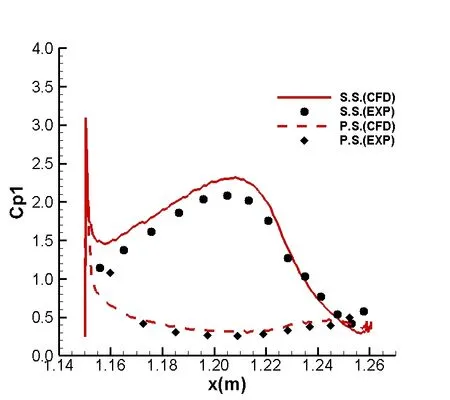
Fig.2 Unsteady pressure coefficient distribution at 50%blade height
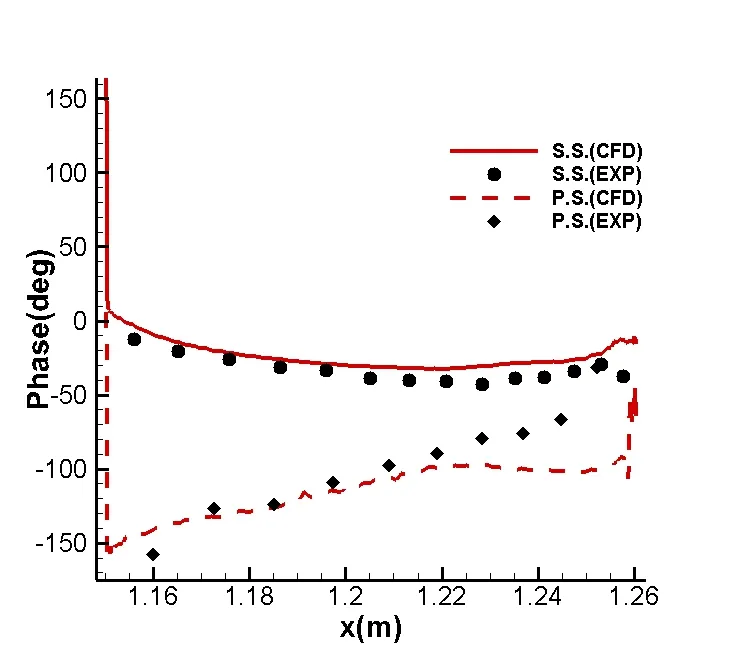
Fig.3 Unsteady pressure phase angle distribution at 50%blade height
4 Effect of reduced frequency on flutter stability and relevant mechanism
To investigate the effect of reduced frequency on flutter stability of compressor/fan blades and uncover corresponding mechanisms,the transonic fan of NASA rotor 67 has been chosen[15].The fan has 22 blades with the design rotational speed of 16,043 RPM.Extensive measurements of the flow field within the transonic fan at its peak efficiency point and a near stall point are available for validation of numerical methods.The fan has also been taken as the test vehicle for aeroelastic investigation[16]-[18],though it does not have any aeroelastic problem.
First,we present the comparison of the calculated speedline and the experimental one,as shown in Fig.4.Three sets of grids with 0.7,1.1 and 1.5 million grid points(designated grid 1,grid 2 and grid 3 respectively)were used to find the cost-effective grid.It can been seen from Fig.4 that the difference in pressure ratio and isentropic efficiency is small between results using grid 2 and grid 3,though there is slight difference between results at the three operating points with the highest pressure ratio using grid 1 and grid 2.It is probably better to use grid 2 for further study,but grid 1 is used later on for unsteady analyses on a whole annulus domain to reduce time cost.
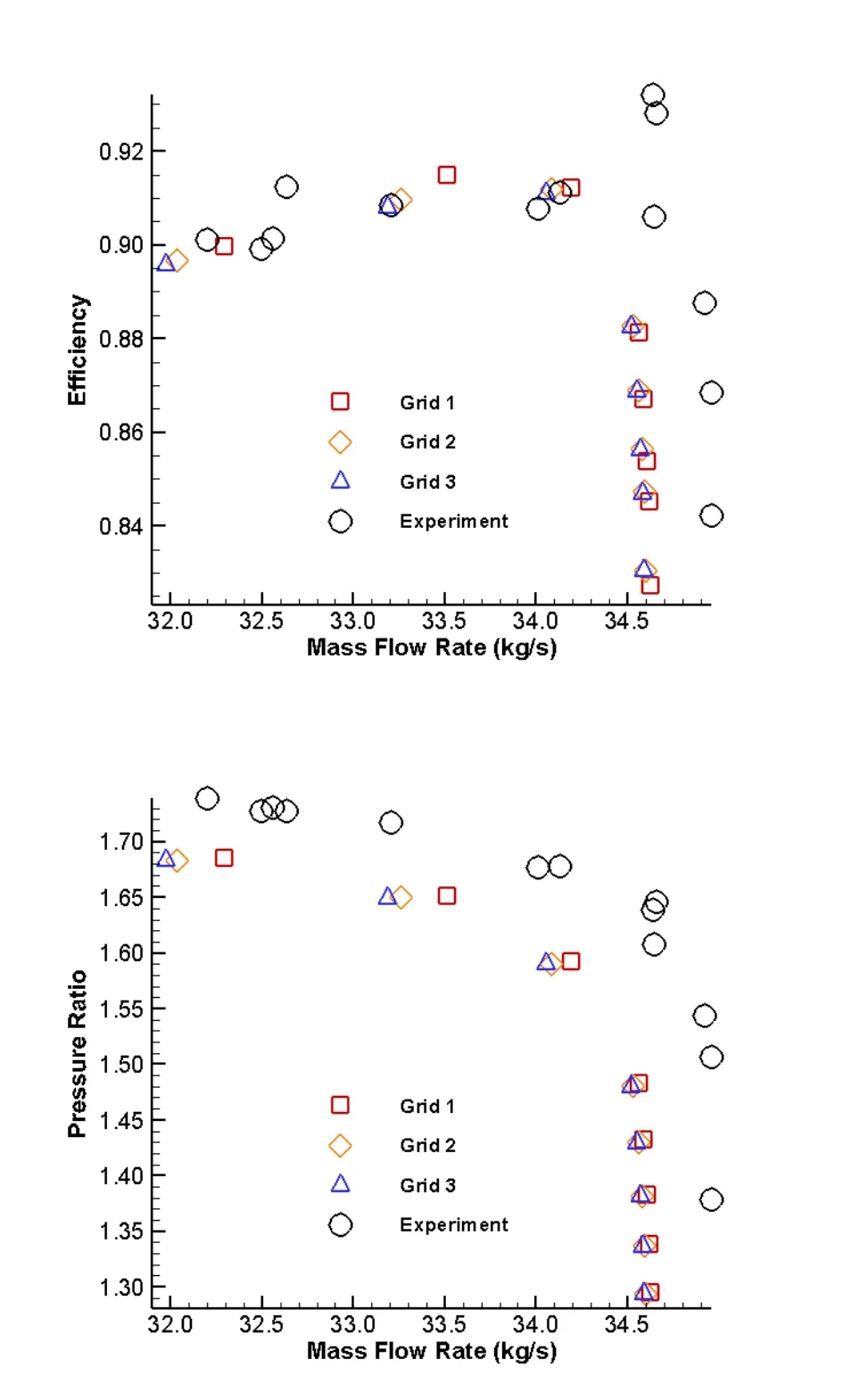
Fig.4 Comparison of measured and computed speedlines of the NASA rotor 67 at its design speed
The calculated choke mass flow rate is 34.7 kg/s which is about 1% lower than the corresponding measured value.This is actually not abnormal as there are quite a few similar under-predictions of choke mass flow of this case reported in the open literature[19],[20].The calculated total pressure ratio is lower for the high end of the pressure ratio -mass flow rate speedline.This discrepancy can be due to the measurement under-resolving the total pressure deficit near end wall regions.
To investigate the mechanism of reduced frequency influence on flutter stability of the transonic fan,the operating point of choice is the one with the highest efficiency obtained using either grid 2 and grid 3.Two vibration modes are considered:one is the first bending mode and the other is the torsion mode.Variation of reduced frequency is achieved by varying the blade’s natural vibration frequency artificially while freezing its corresponding mode shape.As aforementioned,the influence coefficient method is used to obtain worksum for different IBPAs.To avoid errors introduced by computational domain truncation,the whole annulus domain was used.A schematic of the blade to blade view of the whole annulus domain together with the blade indices is shown in Fig.5.Blade suction side is the positive index direction.Blade 11 and blade-11 are the same blade.One should bear in mind,the influence coefficients of blade 0 on all blades can be obtained directly and influence coefficients of other blades on blade 0 are obtained indirectly using the cyclic symmetry feature of the influence coefficients.That is to say,the influence coefficient of blade 0 on blade 1 is equivalent to that of blade 1 on blade 0.
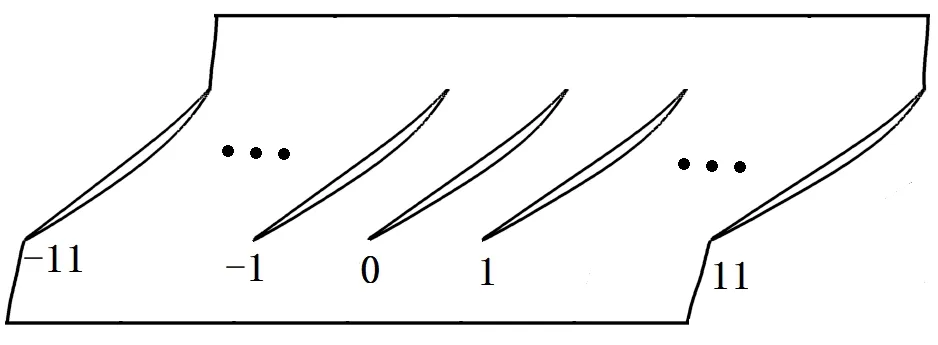
Fig.5 The schematic of a blade to blade view of the computational domain and blade indexing for the NASA rotor 67
4.1 Bending mode
Unsteady flow analyses were performed for 14 different reduced frequencies.The reduced frequency range being considered spans from 0.04 to 0.90 for the bending mode.The chord length and inlet flow velocity being used in the calculation of reduced frequency are 0.1 m and 404 m/s taken at 75% blade height.The worksum characteristics are presented in Fig.6.To provide a clear presentation,the data are presented in two separate figures.From the two figures,we can see that the maximum worksum increases,thus the flutter stability deteriorates,with the reduction of reduced frequency.The least stable IBPA increases with the reduction of reduced frequency.Nevertheless the rate of change of the maximum worksum and the least stable IBPA with respect to reduced frequency is not linear.Before the maximum worksum reaches positive,the rate of change is rather small and it becomes much bigger once the maximum worksum becomes positive.To uncover the mechanism behind this,the worksum-IBPA curves are to be examined in different ways.
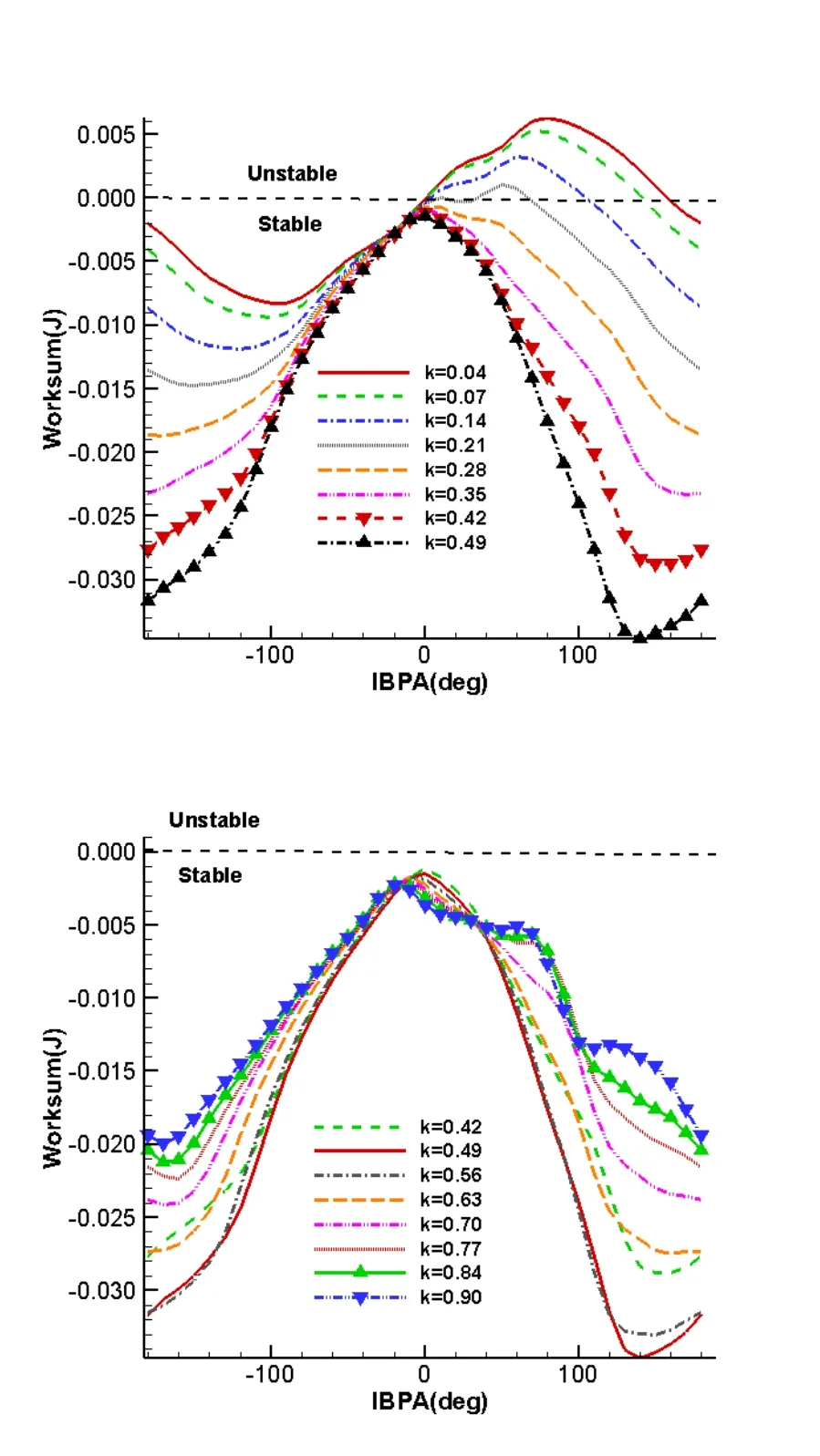
Fig.6 Worksum-IBPA curves for different reduced frequencies for the bending mode
First,the magnitudes of worksum influence coeffi-cients from the center seven blades on blade 0 are examined,as presented in Fig.7.The coefficients decay rapidly for blades away from blade 0 and the ones from blades 0,1 and -1 are the predominant ones.This suggests that it is valid to consider influences from the nearest neighbouring blades only in uncovering the flutter mechanism.This also explains the effective stabilizing effect of alternating mistuning.The influence coefficient magnitude of blade 0 is always the biggest one,that of blade-1 is the second biggest one and that of blade 1 is significantly smaller than that of blade-1.Thus the influence from the nearest two blades is not symmetric.The rate of change of influence coefficient amplitude with reduced frequency is different for different blades,with blade 0 having the biggest rate of change.As a consequence,with the reduction of reduced frequency,the influence of blade 0 is approaching that of blade -1,which plays an important role in determining the blade’s flutter stability.Further the variations of amplitudes of influence coeffi-cients with respect to reduced frequency are not monotonic.The amplitudes increase first,and then reach their peaks and then decrease again with the reduction of reduced frequency.Influence coefficients from different blades reach their peaks at slightly different reduced frequencies,which are around 0.5 for this particular case.

Fig.7 Influence coefficient amplitudes of blades-3,-2,-1,0,1,2,3
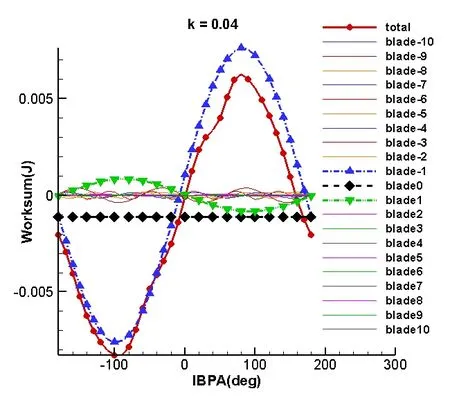
Fig.8 Worksum contributions from all blades at different IBPAs for the bending mode with k=0.004
As aforementioned,the total worksum on a blade can be decomposed into worksums on the blade by unsteady flows induced by each blade vibrating separately.Figures 8-11 present the decomposed worksum variations for all blades at four representative reduced frequencies.The following six points can be concluded from the figure:1)The worksum contribution from blade 0 (that is the work done on a blade by unsteady flow due to its own vibration) does not vary with inter blade phase.The worksum actually represents the mean value of a worksum-IBPA curve.2) The worksum contribution from blade 0 is always negative which means the unsteady flow induced by a blade vibration plays a role of damping for its own vibration.3)Worksum contribution from other blades varies sinusoidally around the zero mean value,thus it can be positive and negative.This implies the worksum from other blades can play a damping or excitation role,depending on the IBPA.4) Worksum contribution from blades-2/2 and beyond are negligibly small which are consistent with data presented in Fig.7.5) At a lower reduced frequency,the worksum contribution from blade 1 is much smaller than that of blade-1,while it increases with the increase of reduced frequency and can reach a level comparable to that of blade-1,which is consistent with the variation of the amplitudes of corresponding influence coefficients with respect to reduced frequency in Fig.7.6) The phase difference in worksum between blade-1 and blade 1 varies with reduced frequency.At the reduced frequency of 0.04,the two worksums are almost out of phase,while at the reduced frequency of 0.49,the two worksums are almost in phase.The phases of the two worksums determine the least stable IBPA.
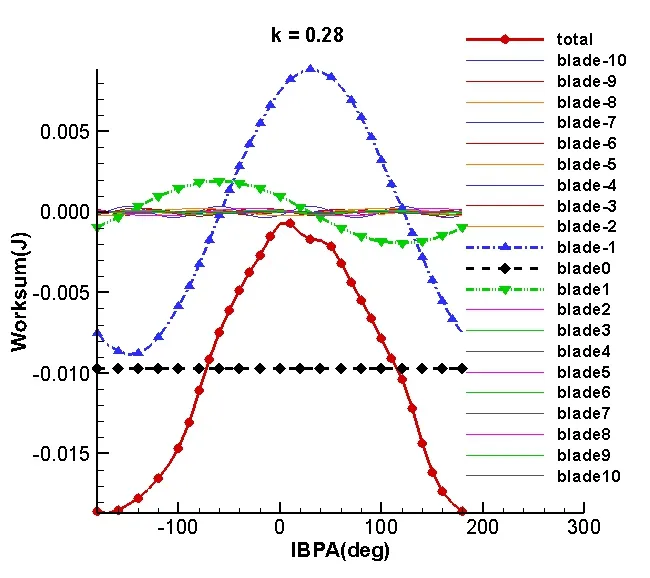
Fig.9 Worksum contributions from all blades at different IBPAs for the bending mode with k=0.28

Fig.10 Worksum contributions from all blades at different IBPAs for the bending mode with k=0.49
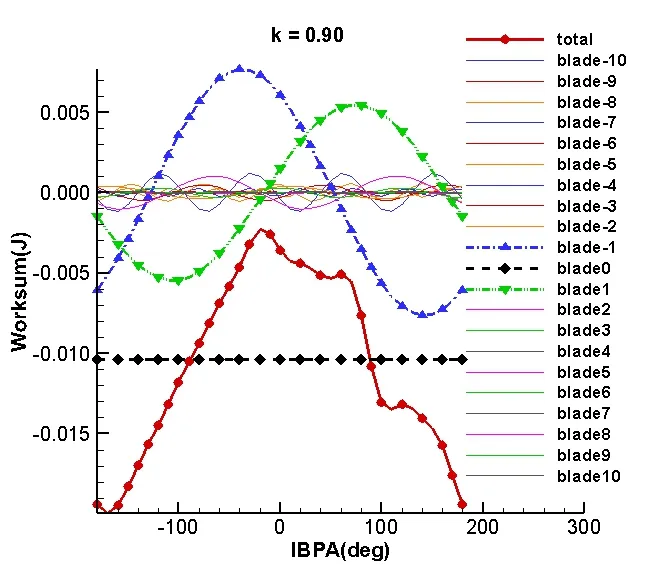
Fig.11 Worksum contributions from all blades at different IBPAs for the bending mode with k=0.90
The variation of the maximum total worksum and corresponding contributions from center five blades is presented in Fig.12.The maximum total worksum curve consists of two line segments,and the turning point(the stability neutral point)is at the reduced frequency of 0.28.The segment on the lower frequency end has a much bigger rate of change,while the other segment is almost flat.The variations of worksum contributions to the total maximum worksum from blades -1 and 1 with reduced frequency are not exactly the same as those of worksum influence coefficients in Fig.7,though the general trends are maintained.The worksum influence coefficients of blades -1 and 1 represent the maximum worksum contributions available.The actual worksum contributions from the two blades depend on IBPA.The worksum contribution to the total maximum worksum from blade -1 is always positive for the frequency range being considered.That implies blade-1 always plays a role of destabilization.Nevertheless,the worksum contribution from blade -1 does not increase,but reduces slightly with the drop of reduced frequency.The worksum contribution from blade 1 reduces almost linearly when the reduced frequency reduces from 0.49 to 0.21,then it remains almost constant at a negative value playing a role of stabilization.The worksum contribution from blade 0 increases dramatically and also scales linearly with the reduced frequency from 0.49 downwards,though it plays a role of stabilization.It is the drastic increase of worksum from blade 0,thus reduction of stabilization,that determines the stability characteristic of the transonic blade with respect to variation of reduced frequency.It is also revealed in the figure that the worksum contribution from blades -2 and 2 both are negligible,particularly for low reduced frequencies.

Fig.12 Maximum worksum and contributions from blades-2,-1,0,1 and 2 for different reduced frequencies for the bending mode

Fig.13 IBPA corresponding to the maximum total worksum,and maximum worksum from blade-1 and blade 1 for the bending mode
Figure 13 presents the variation of the least stable IBPA of the total worksum,and that of the least stable IBPA for the maximum worksum from blade-1 and blade 1.In general,the least stable IBPA of the total worksum increases with the reduction of reduced frequency.There are two frequency ranges over which the IBPA remains constant with a step change between them.This is attributed to the competing influence of and the phase difference in worksum from blade 1 and blade-1.The IBPA corresponding to the maximum worksum from blade -1 follows the same general trend of the IBPA corresponding to the total worksum:it increases with the increase of reduced frequency.The variation is largely linear from the majority part of the frequency range.At the low frequency end,its rate of change is the same as that of the total worksum.This is because the variation of the global least stable IBPA is dictated by that of blade-1.The IBPA corresponding to the maximum worksum from blade 1 has a trend opposite to that of blade-1.Due to the small influence of blade 1,particularly at the low frequency end,this opposite trend of the least stable IBPA of blade 1 has a negligible influence on the global least stable IBPA.
4.2 Torsion mode
Unsteady analyses at nine different reduced frequencies were conducted for the torsion mode.The reduced frequency being considered is narrower than that for the bending mode and ranges from 0.35 to 0.90.This is because the torsion mode has higher natural frequency and reaches instability at a much bigger frequency.The worksum-IBPA characteristics for all the nine frequencies are presented in Fig.14.The variation of the maximum worksum with reduced frequency is very similar to that of the bending mode:the maximum worksum and least stable IBPA increase with the drop of reduced frequency.

Fig.14 Worksum-IBPA curves for the torsion mode
The amplitudes of influence coefficients from the center seven blades are presented in Fig.15.Features similar to those of the bending mode can be observed.Influences from the center three blades are predominant,while influences from other blades are of second order.The influence from blade -1 is much stronger than that of blade 1.There are also features which are different.The amplitude of influence coefficients from blade-1 increases with the drop of reduced frequency from 0.7 to 0.4.Though the variation of the amplitude of influence coefficients of blade 1 has the same trend of that of blade-1,the magnitude of variation is much smaller.It is a fair approximation that the amplitude of influence coefficients of blade 1 remains largely constant.When the reduced frequency is lower than 0.63,the amplitude of influence coefficients of blade 0 is even smaller than that of blade-1.This implies even more important dominance of blade-1 in determining the flutter stability of the blade at this mode.

Fig.15 Influence coefficient amplitude variation with reduced frequency for the torsion mode
Figure 16 presents variations of the maximum total worksum,and corresponding contributions from blades-2,-1,0,1 and 2,against reduced frequency for the torsion mode.Similar to the bending mode,the total maximum worksum curves are composed of two line segments with the turning point at the reduced frequency of 0.56.For reduced frequencies bigger than 0.56,the rate of change of the maximum total worksum is rather small,while the rate of change is rather big for the other part.The worksum contribution from blade-1 remains largely constant for reduced frequencies smaller than 0.56 and increases slightly with the drop of reduced frequency when the reduced frequency is bigger than 0.56.The worksum contribution from blade 1 reduces with the drop of reduced frequency and reaches the minimum at the turning point,and then increases.The wokrsum contribution from blade -1 is much more significant than that from blade 1.The worksum contribution from blade 0 increases monotonically,though not linear over the frequency range.The rate of change increases when the maximum total worksum becomes positive.Similar to the bending mode,the destabilization of the blade at this mode is dictated by the increase of worksum for blade 0 with the reduction of reduced frequency.
The variations of the global least stable IBPA and IBPA corresponding to the maximum worksum of blade-1 and the minimum worksum of blade 1 are presented in Fig.17.Different from the bending mode,at the two ends of the frequency range being considered,the least stable IBPA remains constant.There is a linear increase of the least stable IBPA when the reduced frequency reduces from 0.63 to 0.49.The IBPA corresponding to the maximum worksum of blade -1 remains constant when the reduced frequency is bigger than 0.49.There is a step rise in the least stable IBPA of blade -1 when the reduced frequency varies from 0.49 to 0.42.The most stable IBPA of blade 1 reduces almost linearly with the drop of reduced frequency.At the reduced frequency of 0.56,the worksums of blade -1 and blade 1 are out of phase.Due to the relatively bigger influences of other blades as shown in Fig.16,particularly around the stability neutral point,their influence on the global least stable IBPA becomes relatively bigger in comparison with that of the bending mode.As a consequence,the global least stable IBPA does not follow the least table IBPA of blade-1 exactly around the stability neutral point.

Fig.16 Maximum total worksum and corresponding contributions from blades-2,-1,0,1,and 2 for different reduced frequencies for the torsion mode
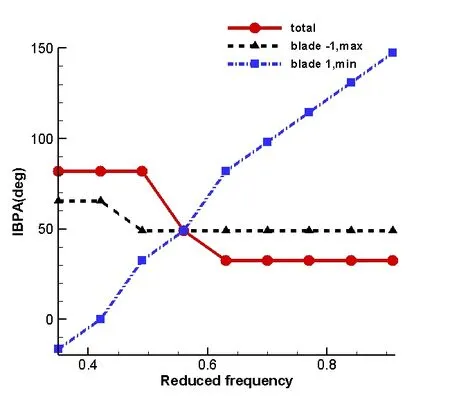
Fig.17 IBPA corresponding to the maximum total worksum,maximum worksum of blade 1 and minimum worksum of blade-1 for the torsion mode
5 Conclusion
To understand the mechanism of reduced frequency effect on flutter stability of transonic compressor/fan blades,the NASA rotor 67 has been chosen as the test vehicle.The effect of reduced frequency on flutter stability of the blade’s first bending and torsion modes has been investigated at its peak efficiency operating point.Variation of reduced frequency is achieved by varying the blade’s vibration frequency artificially to cover flutter stable and unstable regions while freezing its mode shape.The time domain harmonic balance method has been used to achieve efficient analysis of unsteady flow field due to a blade’s vibration.The influence coefficient method is used to obtain the worksum of a vibration mode at all IBPAs through a single numerical analysis.The following conclusions can be drawn from the investigation:
1) For the two considered vibration modes,the influences from a blade own and its nearest two blades play the predominant role in determining flutter stability and influences from other blades are negligible.The unsteady flow due to a blade’s own vibration always plays a role of damping regardless of reduced frequency for the frequency range being considered.The unsteady flow due to vibration of other blades can play a role of damping or excitation depending on IBPA.
2) The two nearest blades have significantly different influences on a blade.The influence from the nearest blade on the pressure side of a blade is much bigger than that of the nearest one on the suction side.At the least stable IBPA,the worksum contribution from the nearest blade on the pressure side always plays a destabilizing role.
3) The total maximum worksum increases with the reduction of reduced frequency,and varies linearly with reduced frequency before and after the stability neutral point(zero worksum).The rate of change of the maximum worksum is much bigger in the unstable region than that in the stable region.
4) For the considered vibration modes,the increase of the maximum worksum with the reduction of reduced frequency is mainly determined by the significant increase of worksum contribution from a blade own.Though not presented in the paper,numerical results show that the rate of reduction of unsteady pressure amplitude(unsteady pressure on a blade due to its own vibration)reduces and the rate of change of unsteady pressure phase increases with the drop of vibration frequency around the stability neutral point.This implies that the worksum increase is mainly due to the change of unsteady pressure phase angle rather than its amplitude.
5) In general,the least stable IBPA increases with the reduction of reduced frequency,though it remains constant over some frequency ranges.The increase of the least stable IBPA arises largely from the increase of IBPA at which the worksum from the nearest blade on a blade pressure side reaches its maximum when the reduced frequency drops.
